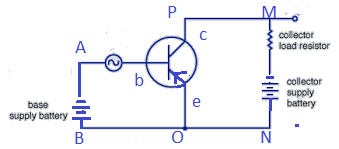
Figure shows the circuit of an electronic device:
i) Which electronic device: a rectifier, an oscillator or an amplifier does the circuit represent?
ii) State where the input voltage is applied and output voltage is available.
iii) Compare the output voltage of this circuit with its input voltage.

Answer
218.7k+ views
Hint: Transistor when supplied with a voltage source at two of its terminals let’s say emitter and base and output is produced at the other two terminals let’s say emitter and collector is performed as an amplifier. Using the above hint we will find out which type of transistor is used in the circuit given in the question above and how it is acting as an amplifier.
Complete step by step solution:
Let’s answer each of point mentioned in the question one by one:
i) The figure shown in the question above circuit diagram represents an Amplifier. Transistor when connected in an active region at both the combination of terminals i.e. emitter base and emitter collector. Active region means that the voltage source connected to an emitter base region and emitter collector region should be forward biased. The above amplifier is a p-n-p transistor common emitter Amplifier. Amplifier is an electronic device which strengthens the weak signal by raising its strength.
ii) Input voltage is applied at the AB terminal of the emitter base junction and the output voltage is produced at MN terminal across the load resistor with an amplified signal.
iii) Output voltage of the amplifier having common emitter configuration is 1800 out of phase as compared to input voltage. The reason for this is that when the input voltage is applied, current through the base circuit increases, which increases the current through the collector circuit also. This collector current lets the transistor on and makes the emitter collector voltage to fall below emitter base voltage, which brings a 1800 phase shift.
Note: Transistor works as amplifier in active region and acts as switch in cut off and saturation regions. Cut off region or saturation is the one in which both the regions of the transistors are reversed bias, base and emitter collector regions. Transistors give 1800 phase shifts only in common emitter configuration.
Complete step by step solution:
Let’s answer each of point mentioned in the question one by one:
i) The figure shown in the question above circuit diagram represents an Amplifier. Transistor when connected in an active region at both the combination of terminals i.e. emitter base and emitter collector. Active region means that the voltage source connected to an emitter base region and emitter collector region should be forward biased. The above amplifier is a p-n-p transistor common emitter Amplifier. Amplifier is an electronic device which strengthens the weak signal by raising its strength.
ii) Input voltage is applied at the AB terminal of the emitter base junction and the output voltage is produced at MN terminal across the load resistor with an amplified signal.
iii) Output voltage of the amplifier having common emitter configuration is 1800 out of phase as compared to input voltage. The reason for this is that when the input voltage is applied, current through the base circuit increases, which increases the current through the collector circuit also. This collector current lets the transistor on and makes the emitter collector voltage to fall below emitter base voltage, which brings a 1800 phase shift.
Note: Transistor works as amplifier in active region and acts as switch in cut off and saturation regions. Cut off region or saturation is the one in which both the regions of the transistors are reversed bias, base and emitter collector regions. Transistors give 1800 phase shifts only in common emitter configuration.
Recently Updated Pages
A square frame of side 10 cm and a long straight wire class 12 physics JEE_Main

The work done in slowly moving an electron of charge class 12 physics JEE_Main

Two identical charged spheres suspended from a common class 12 physics JEE_Main

According to Bohrs theory the timeaveraged magnetic class 12 physics JEE_Main

ill in the blanks Pure tungsten has A Low resistivity class 12 physics JEE_Main

The value of the resistor RS needed in the DC voltage class 12 physics JEE_Main

Trending doubts
JEE Main 2026: Application Form Open, Exam Dates, Syllabus, Eligibility & Question Papers

Understanding Uniform Acceleration in Physics

Derivation of Equation of Trajectory Explained for Students

Hybridisation in Chemistry – Concept, Types & Applications

Understanding the Angle of Deviation in a Prism

Understanding Collisions: Types and Examples for Students

Other Pages
JEE Advanced Marks vs Ranks 2025: Understanding Category-wise Qualifying Marks and Previous Year Cut-offs

Understanding Atomic Structure for Beginners

How to Convert a Galvanometer into an Ammeter or Voltmeter

Understanding Centrifugal Force in Physics

JEE Main Marking Scheme 2026- Paper-Wise Marks Distribution and Negative Marking Details

Degree of Dissociation: Meaning, Formula, Calculation & Uses




